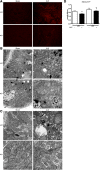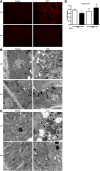Role of Mitochondrial DNA in Septic AKI via Toll-Like Receptor 9
- PMID: 26574043
- PMCID: PMC4926971
- DOI: 10.1681/ASN.2015040376
Role of Mitochondrial DNA in Septic AKI via Toll-Like Receptor 9
Abstract
Toll-like receptor 9 (TLR9) contributes to the development of polymicrobial septic AKI. However, the mechanisms that activate the TLR9 pathway and cause kidney injury during sepsis remain unknown. To determine the role of mitochondrial DNA (mtDNA) in TLR9-associated septic AKI, we established a cecal ligation and puncture (CLP) model of sepsis in wild-type (WT) and Tlr9-knockout (Tlr9KO) mice. We evaluated systemic circulation and peritoneal cavity dynamics and immune response and tubular mitochondrial dysfunction to determine upstream and downstream effects on the TLR9 pathway, respectively. CLP increased mtDNA levels in the plasma and peritoneal cavity of WT and Tlr9KO mice in the early phase, but the increase in the peritoneal cavity was significantly higher in Tlr9KO mice than in WT mice. Concomitantly, leukocyte migration to the peritoneal cavity increased, and plasma cytokine production and splenic apoptosis decreased in Tlr9KO mice compared with WT mice. Furthermore, CLP-generated renal mitochondrial oxidative stress and mitochondrial vacuolization in the proximal tubules in the early phase were reversed in Tlr9KO mice. To elucidate the effects of mtDNA on immune response and kidney injury, we intravenously injected mice with mitochondrial debris (MTD), including substantial amounts of mtDNA. MTD caused an immune response similar to that induced by CLP, including upregulated levels of plasma IL-12, splenic apoptosis, and mitochondrial injury, but this effect was attenuated by Tlr9KO. Moreover, MTD-induced renal mitochondrial injury was abolished by DNase pretreatment. These findings suggest that mtDNA activates TLR9 and contributes to cytokine production, splenic apoptosis, and kidney injury during polymicrobial sepsis.
Keywords: Immunology and pathology; acute renal failure; mitochondria; renal injury.
Copyright © 2016 by the American Society of Nephrology.
Figures










Comment in
-
Mitochondria in Kidney Injury: When the Power Plant Fails.J Am Soc Nephrol. 2016 Jul;27(7):1869-72. doi: 10.1681/ASN.2015111277. Epub 2016 Jan 7. J Am Soc Nephrol. 2016. PMID: 26744487 Free PMC article. No abstract available.
Similar articles
-
IL-17A activated by Toll-like receptor 9 contributes to the development of septic acute kidney injury.Am J Physiol Renal Physiol. 2020 Jan 1;318(1):F238-F247. doi: 10.1152/ajprenal.00313.2019. Epub 2019 Nov 25. Am J Physiol Renal Physiol. 2020. PMID: 31760767
-
Small interfering RNA targeting Toll-like receptor 9 protects mice against polymicrobial septic acute kidney injury.Nephron Exp Nephrol. 2012;122(1-2):51-61. doi: 10.1159/000346953. Epub 2013 Mar 15. Nephron Exp Nephrol. 2012. PMID: 23548820
-
Intra-Peritoneal Administration of Mitochondrial DNA Provokes Acute Lung Injury and Systemic Inflammation via Toll-Like Receptor 9.Int J Mol Sci. 2016 Aug 30;17(9):1425. doi: 10.3390/ijms17091425. Int J Mol Sci. 2016. PMID: 27589725 Free PMC article.
-
Physiological aspects of Toll-like receptor 4 activation in sepsis-induced acute kidney injury.Acta Physiol (Oxf). 2017 Mar;219(3):573-588. doi: 10.1111/apha.12798. Epub 2016 Oct 8. Acta Physiol (Oxf). 2017. PMID: 27602552 Free PMC article. Review.
-
Circulating Mitochondrial DNA Stimulates Innate Immune Signaling Pathways to Mediate Acute Kidney Injury.Front Immunol. 2021 Jun 24;12:680648. doi: 10.3389/fimmu.2021.680648. eCollection 2021. Front Immunol. 2021. PMID: 34248963 Free PMC article. Review.
Cited by
-
Advances in cGAS-STING Signaling Pathway and Diseases.Front Cell Dev Biol. 2022 Feb 3;10:800393. doi: 10.3389/fcell.2022.800393. eCollection 2022. Front Cell Dev Biol. 2022. PMID: 35186921 Free PMC article. Review.
-
The sensing of mitochondrial DAMPs by non-immune cells.Cell Stress. 2019 May 23;3(6):195-207. doi: 10.15698/cst2019.06.190. Cell Stress. 2019. PMID: 31225514 Free PMC article. Review.
-
Mitochondrial dysfunction in sepsis: mechanisms and therapeutic perspectives.Crit Care. 2024 Sep 3;28(1):292. doi: 10.1186/s13054-024-05069-w. Crit Care. 2024. PMID: 39227925 Free PMC article. Review.
-
Early Plasma Nuclear DNA, Mitochondrial DNA, and Nucleosome Concentrations Are Associated With Acute Kidney Injury in Critically Ill Trauma Patients.Crit Care Explor. 2022 Mar 28;4(4):e0663. doi: 10.1097/CCE.0000000000000663. eCollection 2022 Apr. Crit Care Explor. 2022. PMID: 35372847 Free PMC article.
-
Mitochondria: the gatekeepers between metabolism and immunity.Front Immunol. 2024 Feb 23;15:1334006. doi: 10.3389/fimmu.2024.1334006. eCollection 2024. Front Immunol. 2024. PMID: 38464536 Free PMC article. Review.
References
-
- Okusa MD: The changing pattern of acute kidney injury: From one to multiple organ failure. Contrib Nephrol 165: 153–158, 2010 - PubMed
-
- Uchino S, Kellum JA, Bellomo R, Doig GS, Morimatsu H, Morgera S, Schetz M, Tan I, Bouman C, Macedo E, Gibney N, Tolwani A, Ronco C Beginning and Ending Supportive Therapy for the Kidney (BEST Kidney) Investigators : Acute renal failure in critically ill patients: A multinational, multicenter study. JAMA 294: 813–818, 2005 - PubMed
-
- Yasuda H, Kato A, Fujigaki Y, Hishida A Shizuoka Kidney Disease Study Group : Incidence and clinical outcomes of acute kidney injury requiring renal replacement therapy in Japan. Ther Apher Dial 14: 541–546, 2010 - PubMed
-
- Bagshaw SM, Lapinsky S, Dial S, Arabi Y, Dodek P, Wood G, Ellis P, Guzman J, Marshall J, Parrillo JE, Skrobik Y, Kumar A Cooperative Antimicrobial Therapy of Septic Shock (CATSS) Database Research Group : Acute kidney injury in septic shock: Clinical outcomes and impact of duration of hypotension prior to initiation of antimicrobial therapy. Intensive Care Med 35: 871–881, 2009 - PubMed
Publication types
MeSH terms
Substances
LinkOut - more resources
Full Text Sources
Other Literature Sources
Medical
Molecular Biology Databases
Miscellaneous

